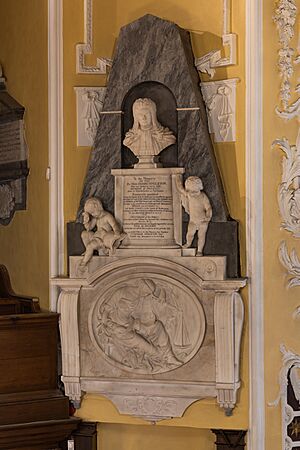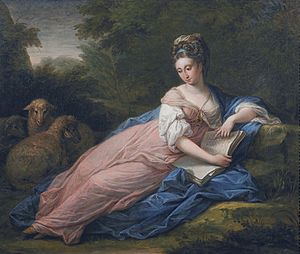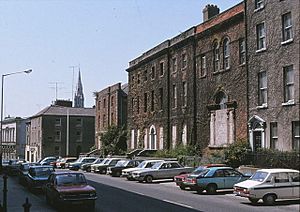Henry Singleton (judge) facts for kids
Henry Singleton (born 1682, died 1759) was an important Irish politician and judge. People remember him today mainly because he was a good friend of the famous writer Jonathan Swift. He is also remembered for his amazing kindness during the Great Irish Famine of 1740-1741. During this terrible time, many people died. Henry Singleton gave a lot of his own money to help those who were suffering. His beautiful home in Drogheda, called Singleton House, is no longer standing.
Contents
Henry Singleton's Career
Becoming a Politician
Henry Singleton was born in Drogheda, a town in Ireland. He was one of eleven children. His father, Edward Singleton, was also a Member of Parliament (MP) for Drogheda. An MP is a person chosen to represent people in the government.
Henry went to school at Drogheda Grammar School. Then he studied at Trinity College Dublin. After that, he became a lawyer in 1707. Like his father, he became an MP for Drogheda in the Irish House of Commons. This was like the parliament in Ireland at the time.
He also worked as the Recorder of Drogheda from 1708. This was a legal job. Later, he became the Prime Serjeant-at-law in 1726. This was a very busy job for a lawyer. Henry hoped to get an easier job later on. In 1733, he almost became the Speaker of the House. The Speaker leads the discussions in parliament. But he didn't get the job. After this, he became less interested in politics.
Becoming a Judge
In 1739, a very important job opened up: Lord Chancellor of Ireland. This is the highest judge in the country. Henry Singleton really wanted this job. He said he had worked hard for the King for fifteen years. He hoped for "a place of more ease," meaning a less stressful job. However, the King usually chose English judges for this role, not Irish ones. So, Henry was not chosen.
Finally, in 1740, Henry Singleton became a judge. He was made the Chief Justice of the Irish Common Pleas. People said he brought "learning and judgment" to his new role. This means he was smart and fair.
After a few years, Henry's health started to get worse. He often visited places like Bath and Spa to try and feel better. He didn't want to leave his job, even when his nephew, William Yorke, wanted to take his place. In 1753, Henry finally resigned as Chief Justice. The next year, he became the Master of the Rolls in Ireland. This job was mostly an honorary title back then, not a very busy one. He was said to do it with "great dignity."
Later, he was asked to help the government again in politics. But people quickly saw that he was "too worn out" to do much. He had a stroke soon after, which made it hard for him to speak. In 1754, people thought he might die, but he got a little better.
Death and Burial

Henry Singleton kept his job as Master of the Rolls until he died. His health problems continued to get worse. He died in 1759 and was never married. He was buried in St. Peter's Church of Ireland, Drogheda. His nephew, Sydenham Singleton, built a beautiful monument there to remember him. The monument was made by the sculptor John Hickey. Henry's large collection of law books is now kept at Columbia University.
Henry Singleton's Family
In his will, which is a legal document about what happens to your things after you die, Henry Singleton left many gifts to his sisters, nephews, and nieces. His main heir was his niece, Mary. She was the daughter of his brother, Reverend Rowland Singleton.
Mary married Philip Tisdall, who was a very important lawyer and politician in Ireland. He was the Attorney General for Ireland from 1760 to 1777. Philip Tisdall hoped to get Henry's old job as Master of the Rolls, but he didn't. Mary was known for being very beautiful. She and Philip were both painted by a famous Swiss artist named Angelica Kauffman.
Where Henry Singleton Lived
In 1731, Henry Singleton built a grand house in Drogheda called Singleton House. It was a large, three-story mansion made of red brick. It had many windows and beautiful wooden walls inside. Sadly, the house became run-down in the 1900s and was torn down in 1989.
In Dublin, Henry lived in Belvedere House in Drumcondra. He rented this house from his friend Marmaduke Coghill and made many improvements to it. He also owned land in County Cavan.
Henry Singleton's Character
Henry Singleton was sometimes called "the Prime Serjeant Grand" because he seemed very serious. But those who knew him well loved and respected him. He was a close friend of Jonathan Swift, who called him "the first of the worthiest." This means Swift thought he was a truly good person.
William Yorke, who took over as Chief Justice after Henry, spoke very highly of him as both a man and a judge. Another good friend was the politician and judge Robert Lindsay. Even George Stone, a powerful Archbishop, thought highly of Henry.
The best example of Henry's good character was his actions during the Great Famine of 1740-1741. He gave a lot of his own money to help the poor people of Drogheda. Drogheda was one of the towns hit hardest by the famine. He even closed the court he worked in so he could go home and help manage the relief efforts.





